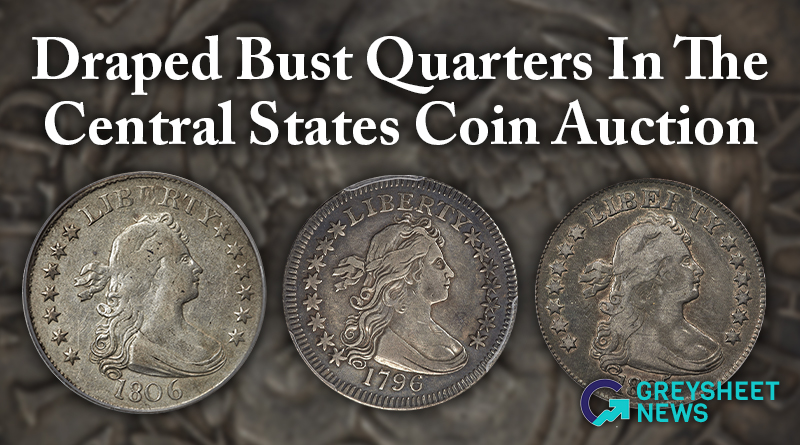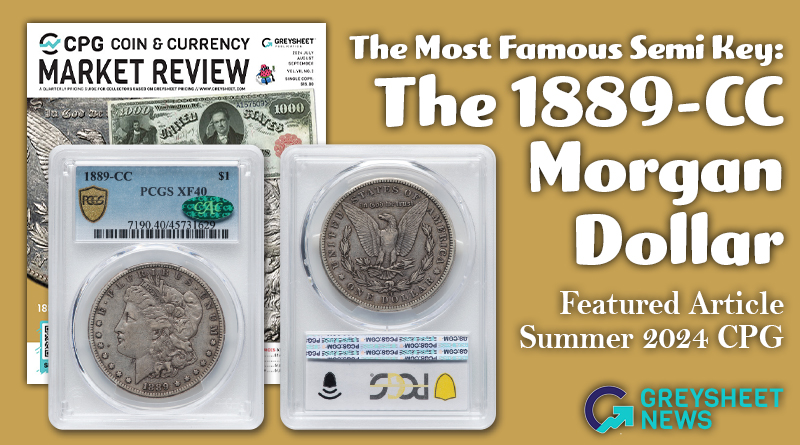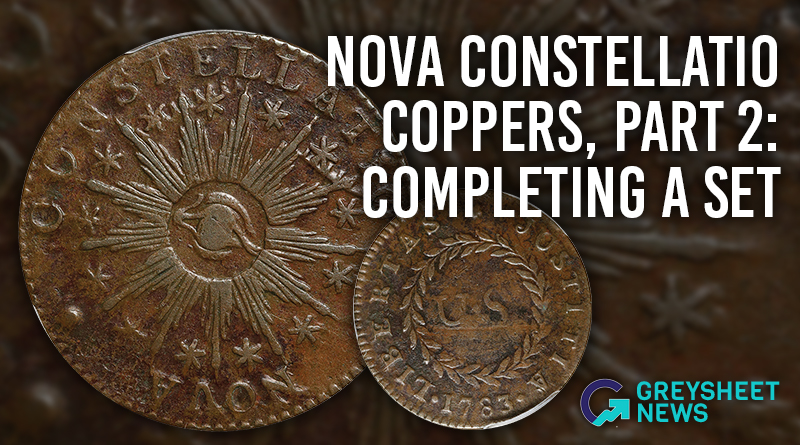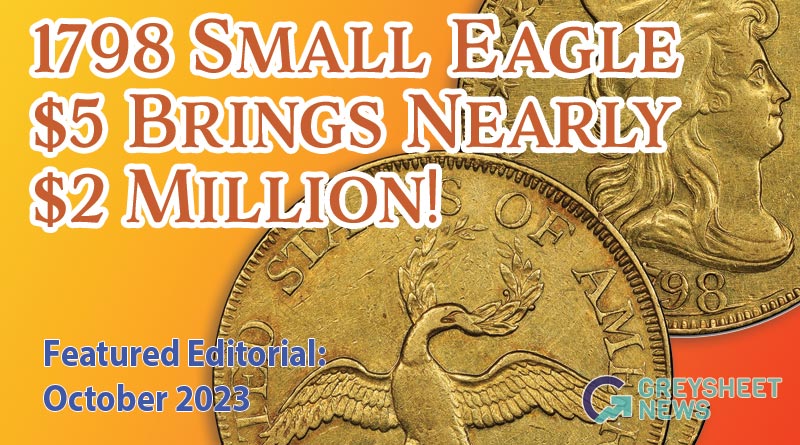A Sleeping Rarity Awakens: 1798 Small Eagle $5 Brings Nearly $2 Million
Not to be confused with their "more common" Large Eagle reverse cousins, the 1798 Small Eagle $5 gold pieces are really rare.
This is the sixth installment in a series on the auctions by Heritage of the Harry Bass Core Collection (HBCC) of U.S. coins and patterns. The fourth and last of the auction sessions was conducted by Heritage on August 10 in Pittsburgh at the David Lawrence Convention Center in conjunction with the summer ANA Convention. Before providing additional coverage of this auction, it makes sense to focus upon the most newsworthy result, the price realized of $1.98 million for a PCGS graded AU53 1798 $5 gold coin with a Small Eagle reverse design.
While 1798 Heraldic Eagle—also called Large Eagle—$5 gold coins are rare, these are not extremely rare overall. It is not difficult to find and acquire one 1798 Heraldic Eagle five. The presently discussed 1798 $5 gold coins are distinguished by their Small Eagle reverse design.
Bust Right obverse, Small Eagle reverse $5 gold coins were minted in quantities in 1795 and 1796, and to some extent in 1797. Probably, a reverse die of the 1795–97 type was used in 1798 because it was the only $5 gold coin reverse die available at a particular moment. It is logical to assume that U.S. Mint employees in 1798 who were instructed to produce $5 gold coins used the materials and equipment that were ready to be used while they were following orders. In later eras, coin collectors sought to identify design types and varieties with precision.
Coin related terminology is often very imprecise. The word eagle has more than one meaning in the realm of U.S. gold coins, as it refers to denominations (face values coupled with structural concepts) and also to representations of the national bird in the designs. A half eagle is a $5 gold coin and a quarter eagle is a $2.50 gold coin. The 1798 Small Eagle half eagle is very unusual in that it was dated after the Heraldic/Large Eagle reverse design was already adopted for half eagles.
As I emphasized in an article in 2016, which is still available online, this is a sleeping rarity. Indeed, the four known privately owned pieces have all traded in the twenty-first century, three times at auction and one just privately, yet these never receive much attention. They are quiet.
An 1822 or 1854-S half eagle commands headlines. Rare gold coin enthusiasts are likely to talk about 1854-S quarter eagles, 1854-D or 1875 Three Dollar gold pieces, 1815 or 1829 half eagles, 1804 or 1875 eagles, and 1856-O double eagles. Collectors frequently discuss 1907 Ultra High Relief and 1927-D Saint Gaudens $20 gold coins. When I talk to coin clubs, hardly anyone recollects ever hearing of or reading about a 1798 Small Eagle $5 gold coin. Even an 1804 13-star reverse quarter eagle has been more likely to be covered in conversations and in the media, though it is not nearly as rare as a 1798 Small Eagle five and is a minting anomaly rather than being indicative of a different reverse design.
Research cited in the Bass Part 4 Heritage auction catalogue suggests that there may be more than seven 1798 Small Eagle half eagles around in the present. Unless solid evidence of the existence of even a seventh is presented, in my view, it is best to refer to six being clearly known, two of which are in the Smithsonian Institution.
Many years ago, Saul Teichman determined that the Pogue 1798 Small Eagle five was earlier in the Farouk and Baldenhofer collections. Additionally, Teichman convincingly maintains that the Jon Kardatzke coin, which the Goldbergs auctioned in June 2000, is the same 1798 Small Eagle half eagle that was earlier in the famous William Atwater and George Earle Collections.
The Eliasberg-Bass 1798 Small Eagle half eagle and the Farouk-Baldenhofer-Pogue coin are the only two that I have seen. The Pogue 1798 Small Eagle five is superior to the Bass coin, though not because it was PCGS graded AU55. I believe and I hope that the Pogue coin would have been CAC approved in 2015 if it had been PCGS or NGC graded AU50 rather than AU55. It may possibly have been CAC approved if it had been graded AU53. The Pogue coin is characterized by neat natural toning and is really pleasing.
The Eliasberg-Bass coin, which is PCGS graded AU53, has very apparent wear, numerous hairlines and a significant number of noticeable pricks. It is at least two shades too light overall, in my opinion. On PCGS CoinFacts, Ron Guth referred to this coin in the past as having an “estimated grade” of XF40. In his article of August 15, 2000, which remains posted on the PCGS website in 2023, John Dannreuther reports that he grades this Eliasberg-Bass coin as “EF-40+,” which is consistent with my grade of XF40 to XF45. Nevertheless, it is an appealing coin, much better than I thought I would find it to be. It is certainly of higher quality than many surviving eighteenth century half eagles of other dates.
The difference between the $1.98 million price realized by the Eliasberg-Bass coin in August 2023 and the $1.175 million price realized by the Pogue coin in September 2015 was due largely to changes in market realities, though not entirely so. Most other gold rarities, especially early eagles (U.S. $10 gold coins), brought strong to very strong prices in the Pogue II sale by Stack’s Bowers with Sotheby’s on September 30, 2015. The Farouk-Pogue 1798 Small Eagle five was below the trend in that auction; the $1.175 million price was moderate, somewhere around the wholesale to retail border.
In contrast, the $1.98 million result for the Eliasberg-Bass coin on August 10, 2023, was clearly strong and unquestionably a retail price. Though absolute market levels for 1798 Small Eagle half eagles were never higher, relative prices were higher in the past.
In the Stack’s Baldenhofer sale in 1955, the 1797 half dollar that was later owned by the Norweb family realized $1,750 and the 1798 Small Eagle five that was later in the Pogue Collection realized $6,000, 3.4 times the price of the Norweb-Baldenhofer 1797 half. In January 2023, Heritage auctioned this same 1797 half dollar for $1,560,000. If this 2023 result is multiplied by 3.4, would the product of $5,349,240 be a sound estimate of how much the Pogue 1798 Small Eagle five would realize if auctioned in 2023? No, the values of 1798 Small Eagle fives relative to other early rarities have declined.
The Atwater Collection 1798 Small Eagle five is probably close enough in quality to the presently discussed Eliasberg-Bass coin such that its value is similar. In 1946, the firm of B. Max Mehl sold the William Atwater Collection. The 1885 Trade dollar, which became the Eliasberg Collection coin, then sold for $1,450. The Atwater Collection 1798 Small Eagle five then sold for $3,100, more than twice as much as the Atwater-Eliasberg 1885 Trade dollar. In January 2019, Heritage auctioned this same 1885 Trade dollar for $3.96 million.
Certainly, if it is imagined that the Atwater-Eliasberg 1885 Trade dollar and the Atwater-Kardatzke 1798 Small Eagle five were in the same auction in 2023 or 2024, the 1798 Small Eagle five would NOT realize more than twice as much as that 1885 Trade dollar, like it did in 1946. Indeed, it would probably bring less now than the Atwater-Eliasberg 1885 Trade dollar, which is vastly superior to three of the other four known 1885 Trade dollars.
The tendency of 1798 Small Eagle fives to sleep is not the only reason why their relative values have fallen over time. Since the late 1970s, buyers of Great Rarities have been far more concerned about the quality of the coins than most buyers were from 1925 to 1975.
Copyright ©2023 Greg Reynolds
Insightful10@gmail.com

Download the Greysheet app for access to pricing, news, events and your subscriptions.
Subscribe Now.

Subscribe to The Greysheet for the industry's most respected pricing and to read more articles just like this.
Source: Greg Reynolds
Related Stories (powered by Greysheet News)
View all news
The Lusk set of Draped Bust quarters brought strong results.

The 1889-CC is the second scarcest business strike in the series.

Just six coins are required for a set of true Nova Constellatio Coppers, and the coins selected need not be very expensive.









Please sign in or register to leave a comment.
Your identity will be restricted to first name/last initial, or a user ID you create.
Comment
Comments